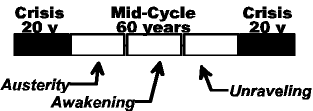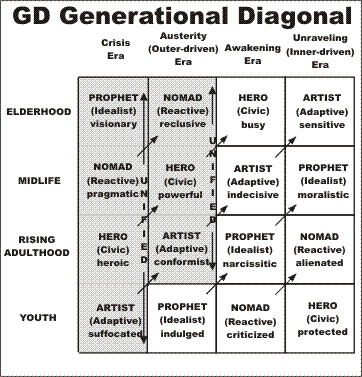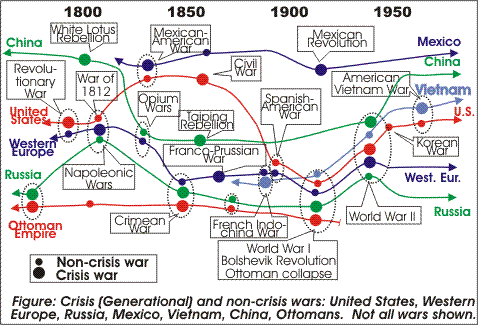
Dynamics

|
Generational Dynamics |
| Forecasting America's Destiny ... and the World's | |
| HOME WEB LOG COUNTRY WIKI COMMENT FORUM DOWNLOADS ABOUT | |
|
These pages contain the complete rough draft manuscript of the new book
Generational Dynamics for Historians,
written by John J. Xenakis.
This text is fully copyrighted. You may copy or print out this
material for your own use, but not for distribution to others.
Comments are invited. Send them to mailto:comments@generationaldynamics.com. |
This chapter presents a summary of the theoretical support for Generational Dynamics.
The major findings of Generational Dynamics begin with the discovery that there are two kinds of wars: crisis (or generational) wars and non-crisis (or mid-cycle) wars.
| |||||||||||||||||||||||||||||||||||||||||||||||||||||||||||||||||||||||||||||||||||||||
Crisis wars are cyclic within a society, region or nation. They're the most horrible kinds of wars. They're so horrible and they traumatize a nation so much that there's unanimous agreement to do everything possible to prevent any such war from ever happening again. When the last generation of people who lived through the crisis war disappear (retire or die) all at the same time, then the nation enters a new crisis period, leading to a new crisis war. That's why a new crisis war typically begins around 60 years after the previous one ends.
Some people may think that America has been immune to genocidal crisis wars, but in fact there have been two since the nation's founding.
America's most recent crisis war was World War II. Before it was over, we firebombed and destroyed major cities like Dresden and Tokyo, with the intention of destroying the cities and their inhabitants, including millions of civilians. And we dropped nuclear weapons on two Japanese cities for exactly the same reason.
I'm not blaming the Allies for taking these genocidal actions, especially since our enemies would have done the same to us. But I'm making the point that genocidal actions like these always occur in crisis wars, and every nation and society has these crisis wars throughout it's history. Crisis wars are fundamental to human DNA, and are a requirement of "survival of the fittest."
Other 20th century wars did not exhibit anything like this kind of genocidal fury. America didn't use nuclear weapons in the Vietnam War, and in fact the war was stalled by bitter political recriminations, which is typical of non-crisis wars. And World War I had no such genocidal fury either, and in fact was mostly a static war in the West, which ended when Germany unexpectedly capitulated, long before it had to.
Prior to World War II, America's previous crisis war was the Civil War. At the climax of the Civil War, President Abraham Lincoln OKed a "scorched earth policy": General Sherman marched through Georgia killing not only everyone in sight, but also destroyed all homes and crops so that any survivors starved to death.
This kind of genocidal behavior did not occur in any of America's other wars -- the Gulf War, the Vietnam War, the Korean War, World War I, the Spanish-American War, or the Mexican-American war.
The latter wars are non-crisis wars. Non-crisis wars are political wars -- they come from the politicians. They can start at any time a politician decides, and they can end at any time.
Crisis wars come "from the people" rather than from the politicians. They're almost like sex in their emotional ferocity. The recur in any society at roughly 70-90 year intervals. Crisis wars may get off to a bumpy start, but once they pick up speed they can't be stopped, and end with a genocidal fury.
About 55-60 years after one crisis war ends, the last generation of people who have personal memories of the genocidal horrors of the preceding crisis war all disappear (retire or die), all at roughly the same time, and the country enters a "generational crisis" period. This appears as a substantial change in attitudes in the public in general. We've already begun to see this in America, with the surprising and unexpected rise of "moral values" as a factor in the 2004 Presidential election. Whenever any country enters a generational crisis period, public opinions continue to harden until a new crisis war breaks out.
We've said that crisis wars tend to occur in 70-90 year cycles in each society, region or nation, but let's be more specific.
In studying the frequency of crisis wars, we've found that the most useful figure to study is the number of years from the end of one crisis war to the beginning of the next.
In an analysis of over 100 crisis wars in nations around the world throughout history, the number of years from the end of one crisis war to the beginning of the next varied from 40 to 117 years, according to the following table:
Fraction
# years of total
------- --------
0- 40 0%
41- 49 11%
50- 59 33%
60- 69 25%
70- 79 16%
80- 89 4%
90- 99 6%
100-117 5%
These figures give an idea of the distribution of crisis wars, and permit an estimate of how frequently crisis wars occur.
The crisis wars are like huge markers on the timeline of history. In between those markers are smaller markers for other significant events. Generational Dynamics has a rich supporting theory that explains how one crisis war leads to the next.
The rich supporting theory is based on work done by historians William Strauss and Neil Howe in the 1980s and early 1990s on generational changes in Anglo-American history. They developed their work by studying hundreds of histories and diaries through Anglo-American history dating back to the 1400s.
Their work is documented in two books, Generations: The History of America's Future, 1584 to 2069 and The Fourth Turning: An American Prophecy.
 |
Based on Strauss and Howe's research, Generational Dynamics identifies crisis and non-crisis periods during a complete generational cycle, or saeculum. These periods are also called "eras" or "turnings." They are:
In the "standard" case, a cycle goes through four turnings, each approximately 20 years long, for a total cycle length of 80 years. But there's a great deal of variation. Some turnings may be unexpected short or long, and if there's no crisis war during the Fourth Turning, then there will be a Fifth Turning, when a crisis war will occur with all but absolute certainty.
Children born in these different periods grow up with characteristics unique to their generation. The differences between people in the same generation are much smaller than the differences between generations.
Strauss and Howe identified the following four generational archetypes, and found that the repeat through the Anglo-American timeline:
 |
The above diagram ties everything together by showing how generations change through the entire cycle. The adjective labels in each square are brief descriptions of the generations in different eras of their life cycle. For example, people in the Artist generation are "suffocated" as they grow up during a crisis period, are "conformist" as young adults, "indecisive" during the Awakening when they're trapped between the two warring generations, and are "sensitive" elder leaders.
Several squares have been darkened in the above diagram to make the point that the generational paradigm is extremely robust and flexible, and corrects itself very quickly after a perturbation.
Suppose that an unexpected invasion or other crisis occurs that literally puts the society in mortal danger at other than the "scheduled" time. Then the society is in the left-hand column with the wrong generations in place. However, at the time of such a crisis, all generations must unite for survival, so generational differences are muted. This unity continues through the Austerity period, and only comes apart during the political conflicts of the Awakening period. But whatever their generational archetype when the entered the Crisis period, they'll become heroes for having fought in the crisis war. The youth generation will be Artists for having grown up during a crisis war. By the Awakening period, the other two generations will have disappeared (retired or died).
This shows that if a perturbation occurs in a society, even a huge perturbation like an unexpected crisis war, then the generational change pattern corrects itself very quickly.
The foundational work in generational theory was done by Bill Strauss and Neil Howe studying diaries and histories written contemporaneously by the people in the actual generations they were studying. They showed that the generational archetypes (Hero, Artist, Prophet, Nomad) occur repeatedly throughout history, always cycling in exactly that order.
Strauss and Howe's work is powerful and fascinating because it provides insight not only into the history of our country, and also into our own personalities, as it helps us understand how generations affect us all. If you wish to understand the flow of American generations, including your own place within recent generations, the above books are good sources.
However, they imposed substantial restrictions on their theory. They say that it applies only to Anglo-American society. They say that it's restricted to modern societies where, "as in America, generations are left free to develop and express their own personalities." According to the authors, the model can't apply to pre-modern societies, or even for most modern societies. However, they suggest that other modern societies should be tested by reading histories, biographies and diaries written by people in those nations.
Generational Dynamics begins where Strauss and Howe leave off, and removes the restrictions. While they base the generational cycle on Awakening periods, Generational Dynamics redevelops the theory starting from crisis wars, and shows that the generational paradigm applies to all societies, regions and nations throughout history.
These are the major concepts that permit Generational Dynamics to apply to all tribes, societies, regions and nations throughout history.
The Principal of Localization says that generational timelines are local to each society, region or nation.
The second principle is that different regions' timelines can merge into a single timeline. This usually happens when the two regions have a crisis war with each other. The two can diverge again -- which happens when one of the regions has a next crisis war with some other nation. But mostly timelines merge over the centuries.
In the thousands of years of recorded history, there have been thousands, or tens of thousands, of individual tribes or societies formed by primitive men and women moving from place to place. Today, there are about 250 nations, comprising about 9 major civilizations (Western, Latin American, African, Islamic, Sinic, Hindu, Orthodox, Buddhist, Japanese).
(Western, Latin American, African, Islamic, Sinic, Hindu, Orthodox, Buddhist, Japanese).
Thus, tribes, societies and nations have physically merged, but the Merging Timelines principle says that their timelines have merged as well. Indeed, what I've shown in my previous book and this one is that, over the millennia, timelines have merged into two major ones in the twentieth century: The World War I timeline and the World War II timeline.
 |
The above graphic shows that the timelines of many countries of the world have merged into two major timelines, one climaxing in WW I and the other climaxing in WW II. Some countries participated in both world wars, but no country participated in both as a crisis war. Generally speaking, WW I was a crisis war for Eastern European countries, and WW II was a crisis war for West European countries. Today, we're approaching the "clash of civilizations" world war, which will merge these last two major timelines into one.